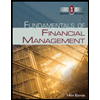
Fundamentals of Financial Management, Concise Edition (with Thomson ONE - Business School Edition, 1 term (6 months) Printed Access Card) (MindTap Course List)
8th Edition
ISBN: 9781285065137
Author: Eugene F. Brigham, Joel F. Houston
Publisher: Cengage Learning
expand_more
expand_more
format_list_bulleted
Textbook Question
Chapter 8, Problem 9Q
In Chapter 7, we saw that if the market interest rate, rd, for a given bond increased, the price of the bond would decline. Applying this same logic to stocks, explain (a) how a decrease in risk aversion would affect stocks’ prices and earned
Expert Solution & Answer
Trending nowThis is a popular solution!

Students have asked these similar questions
Which of the following statements is CORRECT?
a. If the Federal Reserve unexpectedly announces that it expects inflation to increase, then we would probably observe an immediate increase in bond prices.
b. The total yield on a bond is derived from dividends plus changes in the price of the bond.
c. Bonds are generally regarded as being riskier than common stocks, therefore bonds have higher required returns.
d. Bonds issued by larger companies always have lower yields to maturity (due to less risk) than bonds issued by smaller companies.
e. The market price of a bond will always approach its par value as its maturity date approaches, provided the bond's required return remains constant.
THE ANSWER IS NOT E OR B, apparently, but please let me know if you really think one of those choices are correct.
Which one of the following statements is NOT true?
As interest rates increase, bond prices increase.
Interest rate risk is the risk that bond prices will change as interest rates change.
Interest rate changes and bond prices are inversely related.
Long-term bonds have more price volatility than short-term bonds of similar risk
Which of the following statements is the least accurate?
a.
Security returns are composed of cash returns and capital gains.
b.
When the shareholder’s required rate of return is higher than ROE, a company can increase the stock price by retaining and reinvesting more.
c.
The geometric average return is always smaller than or equal to the arithmetic average return.
d.
When the coupon rate is smaller than the yield to maturity, a bond sells below par (discount).
Chapter 8 Solutions
Fundamentals of Financial Management, Concise Edition (with Thomson ONE - Business School Edition, 1 term (6 months) Printed Access Card) (MindTap Course List)
Ch. 8 - Suppose you owned a portfolio consisting of...Ch. 8 - Prob. 2QCh. 8 - Prob. 3QCh. 8 - Is it possible to construct a portfolio of...Ch. 8 - Stock A has an expected return of 7%, a standard...Ch. 8 - A stock had a 12% return last year, a year when...Ch. 8 - If investors aversion to risk increased, would the...Ch. 8 - Prob. 8QCh. 8 - In Chapter 7, we saw that if the market interest...Ch. 8 - Prob. 1P
Ch. 8 - PORTFOLIO BETA An individual has 35,000 invested...Ch. 8 - REQUIRED RATE OF RETURN Assume that the risk-free...Ch. 8 - EXPECTED AND REQUIRED RATES OF RETURN Assume that...Ch. 8 - Prob. 5PCh. 8 - EXPECTED RETURNS Stocks X and Y have the following...Ch. 8 - PORTFOLIO REQUIRED RETURN Suppose you are the...Ch. 8 - BETA COEFFICIENT Given the following information...Ch. 8 - REQUIRED RATE OF RETURN Stock R has a beta of 1.5,...Ch. 8 - Prob. 10PCh. 8 - CAPM AND REQUIRED RETURN Calculate the required...Ch. 8 - REQUIRED RATE OF RETURN Suppose rRF = 9%, rM = 14%...Ch. 8 - CAPM, PORTFOLIO RISK. AND RETURN Consider the...Ch. 8 - Prob. 14PCh. 8 - CAPM AND REQUIRED RETURN HR Industries (HRI) has a...Ch. 8 - CAPM AND PORTFOLIO RETURN You have been managing a...Ch. 8 - PORTFOLIO BETA A mutual fund manager has a 20...Ch. 8 - EXPECTED RETURNS Suppose you won the lottery and...Ch. 8 - EVALUATING RISK AND RETURN Stock X has a 10%...Ch. 8 - Prob. 20PCh. 8 - SECURITY MARKET LINE You plan to invest in the...Ch. 8 - Prob. 22SPCh. 8 - Prob. 23ICCh. 8 - Prob. 1DQCh. 8 - Prob. 2DQCh. 8 - Prob. 3DQCh. 8 - Select one of the four stocks listed in Question 3...Ch. 8 - Go back to the summary page to see an estimate of...Ch. 8 - Prob. 6DQCh. 8 - Prob. 7DQCh. 8 - Beta pf CPB company Beta of the MSI Company is...
Knowledge Booster
Learn more about
Need a deep-dive on the concept behind this application? Look no further. Learn more about this topic, finance and related others by exploring similar questions and additional content below.Similar questions
- Market equity beta measures the covariability of a firms returns with all shares traded on the market (in excess of the risk-free interest rate). We refer to the degree of covariability as systematic risk. The market prices securities so that the expected returns should compensate the investor for the systematic risk of a particular stock. Stocks carrying a market equity beta of 1.20 should generate a higher return than stocks carrying a market equity beta of 0.90. Nonsystematic risk is any source of risk that does not affect the covariability of a firms returns with the market. Some writers refer to nonsystematic risk as firm-specific risk. Why is the characterization of nonsystematic risk as firm-specific risk a misnomer?arrow_forwardExplain whether the following statements are true or false. Justify your answer. a) If interest rate increase the price of a shorter maturity bond will decrease more then a longer maturity bond. b) If rating agencies downgrade a bond, the yield to maturiy on the bond will increase. c) the longer the duration of the bond, the higher will be the reinvestment risk d) The income from bond is more uncertain compared to the income from shares e) Managers want to maximize the intrisic value of the stock not the market price of the stock.arrow_forwardSorry this is a long question, this is all part of this question... The process of bond valuation is based on the fundamental concept that the current price of a security can be determined by calculating the present value of the cash flows that the security will generate in the future. There is a consistent and predictable relationship between a bond’s coupon rate, its par value, a bondholder’s required return, and the bond’s resulting intrinsic value. Trading at a discount, trading at a premium, and trading at par refer to particular relationships between a bond’s intrinsic value and its par value. This also results from the relationship between a bond’s coupon rate and a bondholder’s required rate of return. Remember, a bond’s coupon rate partially determines the interest-based return that a bond (might/will) pay, and a bondholder’s required return reflects the return that a bondholder (Is obligated/Would like) to receive from a given investment. The mathematics of…arrow_forward
- For the holder of a fixed-rate coupon bond, reinvestment risk is a bigger problem during a period of falling interest rates than during a period of rising interest rates. Why, Explain.arrow_forwardConsider the following scenario analysis A. Is it reasonable to assume that treasury bonds will provide higher returns in recessions than in booms? B. Calculate the expected rate of return and standard deviation for each investment. C. What investment would you prefer?arrow_forwardIf the yield curve in the bond market shows a flat curve, what do you think about the prediction of the liquidity premium in explaining this phenomenon? Then do you prefer the prediction of expectation theory in explaining this phenomenon?arrow_forward
- Which of the following statements is false? A. Other things being equal, an increase in a bond’s maturity will increase its interest rate risk. B. Other things being equal, an increase in the coupon rate of a bond will decrease its interest rate risk. C. Other things being equal, an increase in a bond’s YTM will decrease its interest rate risk. D. Effective duration is calculated as Macaulay duration divided by one plus the bond’s yield to maturity.arrow_forwardDo solve all parts A. What risk premium do you use? Why? B. Why is the geometric mean lower than the arithmetic mean for both bonds and bills? C. If you had to use a risk premium with the longer periods, what biases will the investor have?arrow_forwardIs it reasonable to assume that Treasury bonds will provide higher returns in recessions than in booms? Calculate the expected rate of return and standard deviation for each investment. Which investment would you prefer?arrow_forward
- Which of the following statements correctly describes the relationship between a long-term bond’s market value, its coupon rate and the relevant yield to maturity? Group of answer choices A) More than one of the other statements are correct B) None of the other statements are correct C) A government bond with a fixed coupon rate may be valued below its’ face value even though the promised cash flows are effectively riskless. D) If at any point in the bond’s life its coupon rate is less than the market determined yield to maturity, its market value at that time will be less than the face value of the bond. E) When bonds are initially issued, the coupon rate is generally set equal to the required yield to maturity so that the company can issue the bonds at their face value.arrow_forwardIdentify those trends that are unfavorable from theviewpoint of a bondholder. (More than one answer may becorrect.)a. Market interest rates are steadily rising.arrow_forwardWhich one of the following expressions about risk and returns is wrong? A. In general, one reason why a stock is riskier than a bond is that because cash flows from a bond are known and promised, whereas cash flows from a stock are neither known nor promised. B. According to CAPM model, a well-diversified portfolio will have a beta which equals to 0. C. Risk premium is the extra return provided on risky assets to compensate for risk. The difference between risky return and the risk-free return. D. Unexpected return happened because new information came to light which caused our expectations about prices and returns to change.arrow_forward
arrow_back_ios
SEE MORE QUESTIONS
arrow_forward_ios
Recommended textbooks for you
 Fundamentals of Financial Management, Concise Edi...FinanceISBN:9781285065137Author:Eugene F. Brigham, Joel F. HoustonPublisher:Cengage Learning
Fundamentals of Financial Management, Concise Edi...FinanceISBN:9781285065137Author:Eugene F. Brigham, Joel F. HoustonPublisher:Cengage Learning Fundamentals of Financial Management (MindTap Cou...FinanceISBN:9781337395250Author:Eugene F. Brigham, Joel F. HoustonPublisher:Cengage Learning
Fundamentals of Financial Management (MindTap Cou...FinanceISBN:9781337395250Author:Eugene F. Brigham, Joel F. HoustonPublisher:Cengage Learning Fundamentals Of Financial Management, Concise Edi...FinanceISBN:9781337902571Author:Eugene F. Brigham, Joel F. HoustonPublisher:Cengage Learning
Fundamentals Of Financial Management, Concise Edi...FinanceISBN:9781337902571Author:Eugene F. Brigham, Joel F. HoustonPublisher:Cengage Learning Fundamentals of Financial Management, Concise Edi...FinanceISBN:9781305635937Author:Eugene F. Brigham, Joel F. HoustonPublisher:Cengage Learning
Fundamentals of Financial Management, Concise Edi...FinanceISBN:9781305635937Author:Eugene F. Brigham, Joel F. HoustonPublisher:Cengage Learning Fundamentals of Financial Management (MindTap Cou...FinanceISBN:9781285867977Author:Eugene F. Brigham, Joel F. HoustonPublisher:Cengage Learning
Fundamentals of Financial Management (MindTap Cou...FinanceISBN:9781285867977Author:Eugene F. Brigham, Joel F. HoustonPublisher:Cengage Learning Intermediate Financial Management (MindTap Course...FinanceISBN:9781337395083Author:Eugene F. Brigham, Phillip R. DavesPublisher:Cengage Learning
Intermediate Financial Management (MindTap Course...FinanceISBN:9781337395083Author:Eugene F. Brigham, Phillip R. DavesPublisher:Cengage Learning

Fundamentals of Financial Management, Concise Edi...
Finance
ISBN:9781285065137
Author:Eugene F. Brigham, Joel F. Houston
Publisher:Cengage Learning

Fundamentals of Financial Management (MindTap Cou...
Finance
ISBN:9781337395250
Author:Eugene F. Brigham, Joel F. Houston
Publisher:Cengage Learning

Fundamentals Of Financial Management, Concise Edi...
Finance
ISBN:9781337902571
Author:Eugene F. Brigham, Joel F. Houston
Publisher:Cengage Learning

Fundamentals of Financial Management, Concise Edi...
Finance
ISBN:9781305635937
Author:Eugene F. Brigham, Joel F. Houston
Publisher:Cengage Learning

Fundamentals of Financial Management (MindTap Cou...
Finance
ISBN:9781285867977
Author:Eugene F. Brigham, Joel F. Houston
Publisher:Cengage Learning

Intermediate Financial Management (MindTap Course...
Finance
ISBN:9781337395083
Author:Eugene F. Brigham, Phillip R. Daves
Publisher:Cengage Learning
What is modified duration? | Dejargoned; Author: Mint;https://www.youtube.com/watch?v=5yLIybzb_OQ;License: Standard YouTube License, CC-BY